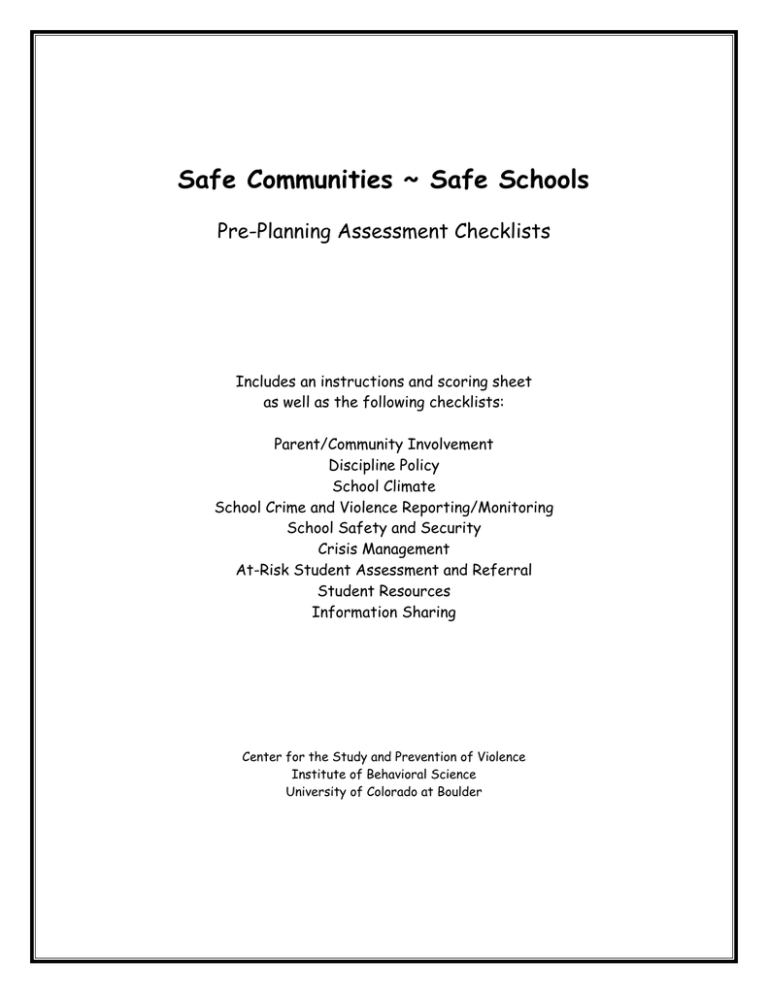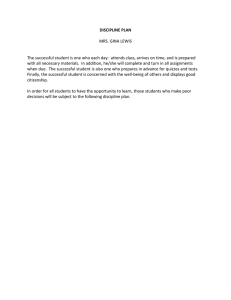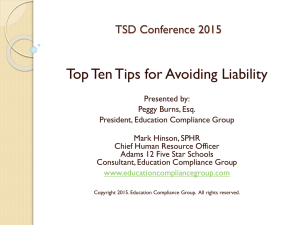Safe Communities ~ Safe Schools Pre
advertisement

Safe Communities ~ Safe Schools Pre-Planning Assessment Checklists Includes an instructions and scoring sheet as well as the following checklists: Parent/Community Involvement Discipline Policy School Climate School Crime and Violence Reporting/Monitoring School Safety and Security Crisis Management At-Risk Student Assessment and Referral Student Resources Information Sharing Center for the Study and Prevention of Violence Institute of Behavioral Science University of Colorado at Boulder 1 Instructions The Safe Communities ~ Safe Schools Pre-Planning Assessment Handbook is intended to aid schoolcommunity planning teams in identifying areas of strength and weakness that could affect school and community safety. This assessment should be completed by those most familiar with the topics covered; perhaps even by teams or subcommittees, and the results used to guide the planning team’s decisions and the development of a safe school plan. For each of the checklists included in this handbook, a score of 1 should be given for any question answered “yes” and a score of 0 for any question answered “no.” The total number of points scored on each checklist (the “Checklist Score”) should be added-up and entered in the spaces provided in the Scoring Sheet, below. Scoring Sheet Topic Checklist Score Parent/Community Involvement Discipline Policy School Climate School Crime and Violence Reporting/Monitoring School Safety and Security Crisis Management At-Risk Student Assessment and Referral Student Resources Information Sharing For each checklist topic, the best possible final score is a 15, which indicates that every item on the checklist for this topic was answered “yes.” A score of 5 indicates that a third of the items were answered “yes,” and so on. These scores can be used to identify areas of strength (highest scores) and weakness (lowest scores) in the existing school safety policies and procedures. 2 Safe Communities ~ Safe Schools Parent/Community Involvement Checklist Yes 1. Does the school have a parent/community volunteer program coordinator? 2. Does the school’s volunteer program draw from retired people, the business community, local citizens, students, and parents? 3. Are all parents asked to volunteer in some way during the school year? 4. Are there a variety of jobs available for volunteers including ones that could be done at home or on weekends to provide for parents/community members who want to help but work during school hours? 5. Are community resources, such as businesses, libraries, parks, and museums used to enhance the learning environment in the school? 6. Has a local business or community organization been asked to “adopt” your school? 7. Does the school serve as a broker of information for parents about before and after school opportunities for children such as daycare, youth organizations, and sports? 8. Are volunteers recognized for their effort and commitment? 9. Are parents/community members included on committees to develop building policies, school-parent compacts, or program improvement activities? 10. Are parents/community members encouraged to solicit ideas from, and report back to, other parent/community members? 11. Does the principal encourage parents/community members to approach him or her if they have questions regarding general school policies or procedures? 12. When a problem arises at the school, such as health or safety issues, does the staff inform and enlist the help of parents/community members immediately? 13. Are there established procedures for dealing with parents’/community members’ demands, especially those of a vocal minority? 14. Does the school provide families the opportunity to learn about all the health and safety activities offered at the school, such as bullying and alcohol/drug prevention programs? 15. Does the school have a parent education program that addresses modeling non-violent responses to conflict and rewarding desirable behavior? 3 No Safe Communities ~ Safe Schools Discipline Policy Checklist Yes 1. Does the school publish and keep current a policy handbook for students and parents that covers discipline, absences, homework, dress standards, parent and student rights, and other important issues? 2. Is the student handbook reviewed by both students and staff? 3. Is the discipline policy clear and simply written in a language that is easily understood by students, staff, and parents? 4. Are parents made aware of student behavioral expectations and school discipline procedures? 5. Are parents required to acknowledge student behavioral expectations and school discipline procedures? 6. Do school staff recognize the difference between school discipline incidents (which should be managed within the school) and legal criminal violations (which should be handled by law enforcement)? 7. Are appropriate penalties outlined for violations of the discipline policy? 8. Does the discipline policy provide alternatives to referrals, suspension, and expulsion? 9. Are the rules and penalties outlined in the discipline policy fairly and consistently applied to all students? 10. Are discipline problems handled by every staff member, not just administration? 11. Are the discipline policies (including classroom management policies) enforced consistently by all school staff? 12. Does the discipline policy identify critical goals and standards? 13. Is the discipline policy consistent with local, state, and federal policies and laws (e.g. The Colorado School Violence Prevention and Student Discipline Manual)? 14. Was the discipline policy created with input from staff and the community (e.g., the School Planning Team)? 15. Are discipline and behavioral problems in the school recognized and resolved promptly? 4 No Safe Communities ~ Safe Schools School Climate Checklist Yes 1. Has the school district implemented a safe school plan in compliance with state law section 22-32-109.1(2)(b), C.R.S.? 2. Has the school district adopted a policy concerning bullying prevention and education in compliance with state law section 22-32109.1(2)(a)(X) C.S.R.? 3. Does the school have a bullying prevention program in place? 4. Has the school instituted corrective measures for students engaged in bullying, including training in acceptable behavior, counseling and appropriate discipline? 5. Does the school provide support and counseling for bullying victims to assist them in coping with the effects of bullying and to help them learn techniques that will discourage further bullying? 6. Has the school created opportunities for dialogue to take place among staff, parents and community members on how they can help prevent bullying? 7. Does the school have a program that involves all students in learning positive social skills? 8. Has the school staff been trained in the use of concrete methods for recognizing and praising positive, supportive behaviors of students toward one another? 9. Does the school annually survey students and staff about school safety issues? 10. Is information collected from student surveys used to establish school improvement goals? 11. Is information collected from staff surveys used to establish school improvement goals? 12. Do all staff members treat each other with respect? 13. Do all staff members treat students with respect? 14. Do all students have a close relationship with an adult at the school who they can go to if they have a problem? 15. Does the school emphasize fair play and non-violence on the playground, on the school bus, and at school events? 5 No Safe Communities ~ Safe Schools School Crime and Violence Reporting/Monitoring Checklist Yes 1. Does the school currently have a formal incident reporting system in place? 2. Do all staff have access to this system? 3. Do students have a mechanism for reporting school crime and violence incidents or threats? 4. Do parents have a mechanism for reporting school crime and violence incidents or threats? 5. Are the parent/student reporting mechanisms anonymous (e.g. Safe School Hotline)? 6. Are data maintained and monitored regarding incidents of crime and violence in the school? 7. Are data maintained and monitored regarding incidents of crime and violence during school activities (even activities that are off school grounds)? 8. Are data maintained and monitored regarding police calls for service to the school? 9. Are data maintained and monitored regarding student suspensions and expulsions? 10. Are data maintained and monitored regarding other disciplinary referrals? 11. Are data maintained regarding school drop-out rates? 12. Are data maintained and monitored regarding the level of gang activity in the school? 13. Are data maintained and monitored regarding incidents involving drugs and alcohol (use, selling, etc.)? 14. Are data maintained and monitored regarding incidents of weapon possession in the school? 15. Are data maintained and monitored regarding rates of crime and violence in the community as a whole? 6 No Safe Communities ~ Safe Schools School Safety and Security Checklist Yes 1. Do teachers and other key personnel understand the school’s procedures for handling discipline/behavioral problems? 2. Are appropriate provisions for supervision and security planned for after-hour activities? 3. Is there only one clearly marked entrance for visitors? 4. Are visitors required to sign-in at a central location and wear visitor badges while on the school grounds? 5. Have procedures been developed to handle unauthorized visitors? 6. Has an organized plan been established for routine supervision of halls, lavatories, and school grounds? 7. Has an organized plan been established for routine supervision of all school entrances? 8. Are there established plans for involving the fire department and local law enforcement in school safety and security issues? 9. Is graffiti/vandalism inside the school or on the school grounds promptly removed or fixed when it occurs? 10. In the event of a crisis, is there a central administrative point of contact for information dissemination and decisions? 11. Does the school currently have a plan for assessing and improving physical security? 12. Has the physical layout of the school recently been reviewed for possible safety and security problems? 13. If problems were identified, were they fixed? 14. Is there a system in place for quick, two-way communication between teachers and the central office (intercoms, cell phones, etc.) in case of an emergency? 15. Are all school files and records maintained in locked, vandal proof, fireproof containers (file cabinets, vaults, etc.)? 7 No Safe Communities ~ Safe Schools Crisis Management Checklist Yes 1. Does the school currently have a formal crisis response plan in place? 2. Was this plan developed with input from students, parents, staff and community members? 3. Was this plan developed with input from emergency service providers (police, firefighters, EMTs, etc.)? 4. Is this planned reviewed on an annual basis? 5. Are there appropriate signals that all teachers and staff understand for announcing an emergency situation? 6. Do teachers and other key personnel understand the school’s procedures for handling emergency/crisis situations? 7. Are all students aware of and trained in the crisis response plan? 8. Are all parents aware of and trained in the crisis response plan? 9. Is the chain of command for emergencies clearly defined and understood by teachers and staff? 10. Is there a system in place for swift parental contact when necessary? 11. Does the school have a media or press relations policy? 12. Does the school conduct a routine crisis management drill, including staff, students and community services providers, on at least annual basis? 13. Does the crisis management plan include both early response components (evacuation, lockdown, etc.) and long-term response elements (mental health services for students, parents and community members, etc.)? 14. Does the school have a crisis response backpack or box containing emergency tools such as lists of students/staff with contact information, a walkie-talkie system, a map and school floor plan, and location of power and utility connections? 15. Does the crisis plan include the location and function of your primary and alternate on-site Command Posts? 8 No Safe Communities ~ Safe Schools At-Risk Student Assessment and Referral Checklist Yes 1. Are teachers and other school staff trained in recognizing early warning signs and/or risk factors for violent or other negative behaviors? 2. Are parents provided with information regarding recognizing warning signs and/or risk factors for violent or other negative behaviors? 3. Are students provided with information regarding recognizing warning signs and/or risk factors for violent or other negative behaviors? 4. Do mechanisms exist for teachers to report the identification of possible warning signs in a student? 5. Do mechanisms exist for parents to report the identification of possible warning signs in a student? 6. Do mechanisms exist for students to report the identification of possible warning signs in a student? 7. Does the school have access to (either on site or in the community) professionals who are qualified to assess students exhibiting warning signs? 8. Do formal procedures exist for following-up with students identified as exhibiting early warning signs? 9. Are all teachers and other school staff encouraged to report students showing early warning signs? 10. Are parents encouraged to report students showing early warning signs? 11. Are students encouraged to report other students showing early warning signs? 12. When students are identified as exhibiting early warning signs, does the school contact parents to discuss the student’s needs? 13. Are students identified for the purpose of linking to services, rather than for the purpose of punishing or labeling as a potential threat? 14. If students are identified as exhibiting early warning signs, are they then assessed for service needs? 15. Has your school or district established an Interagency Social Support Team to analyze the behavior of students who have made or demonstrated a potential threat, or are showing early warning signs for being at risk? 9 No Safe Communities ~ Safe Schools Student Resources Checklist Does your school offer the following support for staff, students and their families (including school-linked community services): 1. evaluation/assessment of special needs (educational, emotional, behavioral, etc.) or warning signs for violence 2. early identification of youth in need 3. consultation on mental health issues for teachers 4. violence prevention programs for the whole school 5. individual counseling services 6. group counseling services 7. family counseling services 8. parent counseling services 9. parent training 10. substance abuse services 11. referral for more intensive services (e.g., medication) 12. crisis intervention services 13. support services for well-functioning youth 14, support services for teachers 15. support services for families 10 Yes No Safe Communities ~ Safe Schools Information Sharing Checklist Yes 1. Does your school district have a signed agreement to promote information sharing between the Board of Education and law enforcement for the purposes of keeping each school environment safe in compliance with 22-32-109.1 (3) C.R.S.? 2. Does your school district have a signed agreement to promote information sharing between the Board of Education and criminal justice agencies (e.g. court system and probation) for the purposes of keeping each school environment safe? 3. Does your school district have a signed agreement to promote information sharing between the Board of Education and social service agencies for the purposes of keeping each school environment safe? 4. Does your school district have a designated liaison that coordinates the sharing of information among agencies? 5. Are school staff members aware of the cooperative agreement between Board of Education and Law Enforcement and other agencies? 6. Are school principals notified by the District Attorney’s office when charges are filed against a student at their school? 7. Does law enforcement notify principals about information concerning students which give rise to a public safety concern? 8. Are school principals aware that they may request information from the police or sheriff’s office concerning a student with regard to the following: the arrest of a student for an act constituting a misdemeanor or felony if committed by an adult; the issuance of a municipal summons; any threat or incident perpetrated by the student? 9. Are school principals aware that they may inspect law enforcement records concerning juveniles who are enrolled or will be enrolled in the school in compliance with 19-1-304(2)(a)(XV) C.R.S.? 10. Are school principals aware that they may inspect court records in juvenile delinquency proceedings or proceedings concerning a juvenile charged with any municipal ordinance violation, excluding traffic violations in compliance with 19-1304(1)(a) C.R.S.? 11. Are school principals aware that they must disclose attendance and disciplinary records to any requesting criminal justice agency if the requesting agency needs the information to effectively serve the student prior to adjudication? 12. Is information shared in a timely manner between law enforcement and school officials? 13. Is information shared in a timely manner between social services and school officials? 14. Do representatives from law enforcement, social services, and the school system attend regular interagency planning meetings? 15. Does the Board of Education have a written policy to ensure that confidential offender history information is disseminated only to appropriate and authorized school personnel. 11 No Sources Attorney General of Colorado, “Colorado School Violence Prevention and Student Discipline Manual” Centers for Disease Control, “School Health Index: A Self-Assessment and Planning Guide” Center for Safe Schools and Communities, “A School Security Questionnaire” Center for School Mental Health Assistance, “Survey of Youth Mental Health Issues” and “Survey on Goals for School-Based Mental Health Services” National Educational Service, “Safe Schools: A Handbook for Violence Prevention” National Resource Center for Safe Schools, “Parent Involvement Checklist” and “Parents in Advisory/Decision-Making Roles Checklist” National School Safety Center, “School Safety Check Book” Julie Slayton, Office of Juvenile Justice and Delinquency Prevention, “Establishing and Maintaining Interagency Information Sharing” Ron Stephens, “Safe Schools: A Handbook for Violence Prevention” 12

